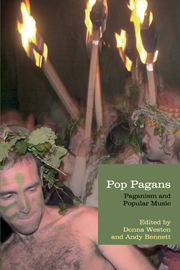1 - Towards a definition of Pagan music
Summary
In 1993, the first international Pagan studies conference was held, bringing together scholars from all over the world in fields as diverse as psychology, theology and ecology. In Researching Paganisms, published in 2004, Blain, Ezzy and Harvey cite multiplicity as central to the discipline of Pagan studies, and note that just as contemporary Paganisms are still evolving, so are the methodologies and approaches of those who choose to study them. Popular music studies is one area in which Pagan studies activity is only just emerging, yet – as seen in a Pagan history of celebration and story-telling through music – it is a voice through which Paganism might readily be expressed. Indeed, as this book explores, popular music has already proved a highly effective medium for the articulation of Pagan ideology and aesthetics. A diverse range of genres, from folk through punk and Goth to heavy metal, frequently embodies images and discourses drawn from Paganism. Similarly, a number of popular music artists profess a deep-seated investment in and expression of Paganism and Pagan identity through their music.
Depending on the interpretation, Paganism is a religion, a worldview, a way of life and even a human trait. This multiplicity varies according to modes of perception, reception and dissemination, and is represented in the range of topics discussed in the chapters of this book. This multiplicity is also reflected in the range of readers to whom this book will appeal: in the broad sense, it will be of benefit not only to those with an interest in Paganism and Pagan studies, but it will also raise questions for those engaged in studies of religion, particularly popular religion.
- Type
- Chapter
- Information
- Pop PagansPaganism and Popular Music, pp. 1 - 12Publisher: Acumen PublishingPrint publication year: 2013



